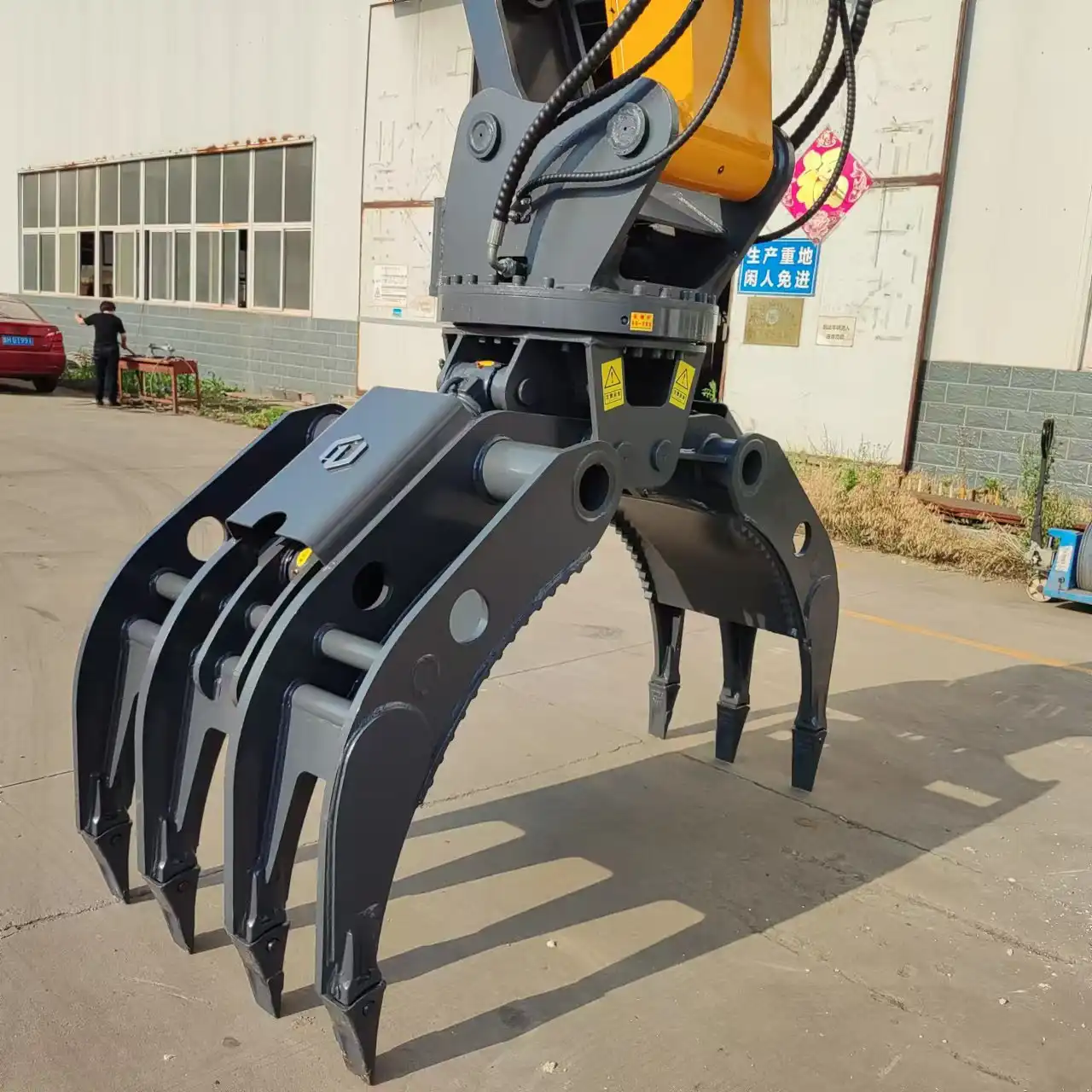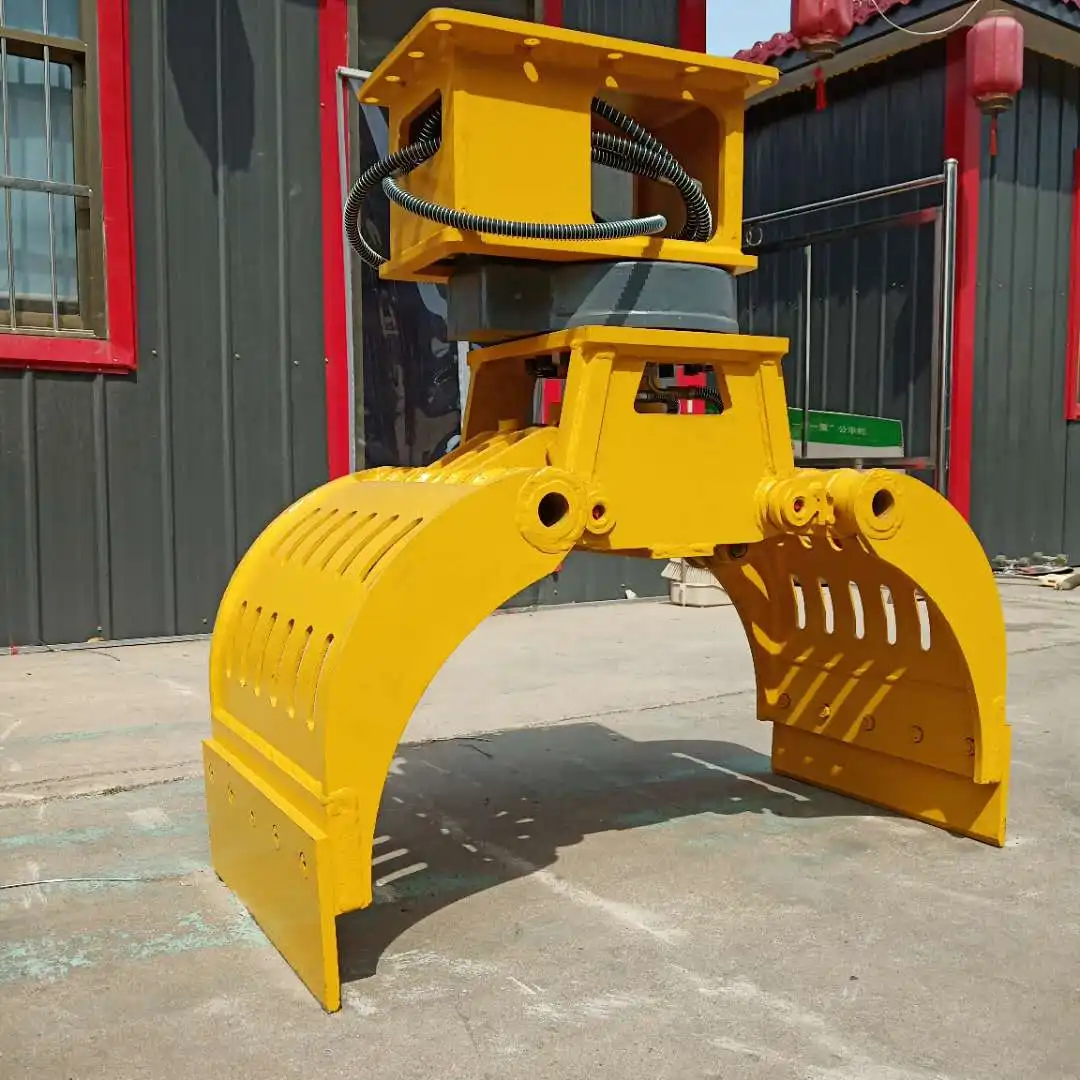What is the difference between an excavator and a backhoe attachment?
The fundamental difference between excavator attachments and backhoe attachments lies in their engineering specifications, compatibility requirements, and operational capabilities.
Excavator's attachments are purpose-built for dedicated hydraulic excavation machines that feature 360-degree rotation, advanced hydraulic systems, and specialized mounting interfaces. These attachments leverage superior hydraulic flow rates and pressure capabilities, enabling them to handle heavier loads and perform more specialized tasks. Backhoe attachments, conversely, are designed for tractor-mounted backhoe loaders that operate with limited rotation ranges and different hydraulic configurations. The attachment mounting systems differ significantly, with excavator interfaces requiring robust quick-coupler mechanisms that accommodate higher stress loads, while backhoe attachments utilize simpler mounting brackets suited for their operational limitations.

Core Purpose and Design
The architectural differences between excavator and backhoe attachments reflect their machines' distinct operational philosophies and mechanical capabilities. Attachments for excavators embody specialized engineering that maximizes the potential of dedicated earthmoving machines, while backhoe attachments represent versatile solutions designed for multi-purpose tractor platforms. These fundamental design approaches create substantial differences in performance characteristics, durability requirements, and application suitability.
Structural Engineering Differences
Excavator attachment construction incorporates advanced metallurgy and precision engineering techniques that accommodate the extreme forces generated by dedicated hydraulic systems. These attachments feature reinforced stress points, sophisticated wear protection systems, and robust mounting interfaces designed to withstand continuous heavy-duty operations. The structural design philosophy emphasizes maximum durability and performance optimization, reflecting the excavator's role as a specialized earthmoving platform.
Professional-grade excavator attachments integrate advanced materials science with precision manufacturing techniques to deliver exceptional operational longevity. High-strength steel alloys, specialized heat treatment processes, and strategic reinforcement placement create attachments capable of sustained performance under demanding conditions. The integration of modular wear components enables cost-effective maintenance while preserving structural integrity throughout extended operational cycles.
Hydraulic System Integration
Hydraulic system compatibility represents a critical distinction between excavator and backhoe attachments, with each category optimized for different pressure ranges, flow rates, and control mechanisms. Excavator attachments leverage sophisticated hydraulic circuits that provide proportional control, variable flow adjustment, and advanced safety systems. These systems enable precise material manipulation while maintaining operational efficiency across diverse applications.
Contemporary hydraulic integration incorporates computerized control systems that optimize attachment performance based on operational parameters and material characteristics. Advanced pressure regulation, temperature monitoring, and flow optimization ensure consistent performance while protecting both attachment and machine components. These sophisticated systems deliver operational precision that enables complex tasks requiring delicate material handling alongside powerful digging operations.
Mounting Interface Technology
Quick-change mounting systems for excavator attachments incorporate advanced mechanical and hydraulic technologies that enable rapid attachment swapping without compromising operational safety or performance. These sophisticated interfaces feature automatic locking mechanisms, hydraulic activation systems, and safety interlocks that prevent accidental disconnection during operations. The engineering emphasis focuses on maximizing operational flexibility while maintaining structural integrity under extreme loading conditions.
Modern mounting interface design integrates multiple safety systems and operational enhancements that streamline attachment changes while ensuring operator protection. Automatic hydraulic connection systems eliminate manual coupling procedures, reducing changeover time and minimizing safety risks. The incorporation of diagnostic systems enables real-time monitoring of connection integrity, hydraulic pressure, and attachment status throughout operational cycles.

Machine Compatibility
Machine compatibility considerations encompass hydraulic specifications, mounting configurations, and operational parameters that determine attachment performance and safety. Excavator attachments require precise matching with excavator hydraulic systems, quick-coupler interfaces, and operational characteristics to achieve optimal performance. Backhoe attachments accommodate the different hydraulic pressures, flow rates, and mounting systems associated with tractor-based platforms, creating distinct compatibility requirements that influence attachment selection and procurement decisions.
Hydraulic System Requirements
Hydraulic system compatibility demands precise matching between attachment requirements and machine capabilities across pressure ranges, flow rates, and control system specifications. Excavator hydraulic systems typically operate at higher pressures and flow rates compared to tractor-based backhoe systems, enabling more powerful and responsive attachment operation. Understanding these specifications becomes essential for ensuring optimal attachment performance while preventing system damage or operational inefficiencies.
Professional hydraulic system integration requires a comprehensive analysis of machine specifications, attachment requirements, and operational demands to achieve optimal compatibility. Advanced hydraulic circuits incorporate variable displacement pumps, load-sensing systems, and electronic control modules that optimize performance based on attachment characteristics and operational requirements. These sophisticated systems deliver consistent performance while minimizing energy consumption and reducing operational costs.
Physical Mounting Considerations
Physical mounting compatibility encompasses dimensional specifications, weight distributions, and structural interfaces that ensure safe and effective attachment operation. Excavator mounting systems accommodate higher attachment weights and operational forces compared to backhoe platforms, requiring robust structural interfaces and comprehensive safety systems. The dimensional compatibility between attachment and machine determines operational reach, lifting capacity, and overall performance characteristics.
Contemporary mounting system design emphasizes standardization and universal compatibility while maintaining the structural integrity required for demanding applications. Industry-standard quick-coupler interfaces enable attachment interchangeability across different excavator manufacturers, maximizing fleet flexibility and reducing inventory requirements. Advanced mounting systems incorporate diagnostic capabilities that monitor connection integrity and operational parameters throughout attachment use.

Performance and Capabilities
Performance differentials between excavator and backhoe attachments reflect their respective machine platforms' capabilities and design philosophies. Excavator attachments deliver superior digging force, operational precision, and specialized functionality that leverages the excavator's dedicated hydraulic systems and structural design. These performance advantages enable complex operations, heavy material handling, and specialized applications that exceed backhoe attachment capabilities.
Operational capability analysis reveals significant differences in productivity potential, application versatility, and operational efficiency between excavator and backhoe attachment systems. Advanced performance metrics encompass cycle times, fuel efficiency, operational precision, and maintenance requirements that influence total cost of ownership and project profitability. Understanding these performance characteristics enables informed equipment selection decisions that optimize project outcomes while controlling operational costs.
Power and Force Delivery
Power delivery characteristics represent fundamental differences between excavator and backhoe attachment systems, with excavator attachments leveraging superior hydraulic capacity for enhanced performance. Higher hydraulic pressure and flow rates enable excavator's attachments to generate greater digging forces, lifting capacities, and operational speeds compared to backhoe alternatives. These power advantages translate directly into improved productivity and enhanced capability for demanding applications.
Contemporary power delivery systems incorporate variable displacement technologies and load-sensing capabilities that optimize performance based on operational requirements. Advanced hydraulic circuits automatically adjust pressure and flow parameters to match attachment demands while minimizing energy consumption. These sophisticated systems deliver consistent performance across varying operational conditions while extending component lifespan and reducing maintenance requirements.
Operational Precision and Control
Operational precision capabilities distinguish excavator attachments through their integration with advanced hydraulic and electronic control systems. Proportional control systems enable delicate material manipulation alongside powerful digging operations, providing operators with exceptional versatility across diverse applications. The precision control capabilities enable complex operations that require careful material handling, accurate positioning, and controlled force application.
Advanced precision control systems incorporate feedback mechanisms and automated adjustment capabilities that enhance operational accuracy while reducing operator workload. Electronic control modules monitor operational parameters and provide real-time adjustments that optimize attachment performance based on material characteristics and operational conditions. These sophisticated systems enable consistent results across varying operational scenarios while minimizing the potential for operator error.
FAQ
①Can backhoe attachments work on excavators?
Generally, backhoe attachments cannot directly mount on excavators due to different hydraulic specifications, mounting interfaces, and operational requirements. Excavators require attachments designed for their specific systems.
②Which attachments offer better performance?
Excavator attachments typically deliver superior performance due to higher hydraulic capacity, advanced control systems, and specialized engineering that maximizes the excavator's capabilities.
③How do I choose between excavator and backhoe attachments?
Consider your machine type, operational requirements, hydraulic specifications, and performance needs. Excavator attachments suit specialized, high-performance applications, while backhoe attachments work for general-purpose tasks.
④Are excavator attachments more expensive?
Excavator attachments often cost more due to advanced engineering, superior materials, and specialized manufacturing processes, but they typically provide better performance and longer operational life.
⑤What maintenance differences exist between attachment types?
Excavator attachments may require specialized maintenance procedures due to advanced hydraulic systems, while backhoe attachments generally follow simpler maintenance schedules aligned with tractor service requirements.
When it comes to high-quality excavator attachments, TianNuo Machinery is your go-to choice. As a professional manufacturer and supplier in China, we have been committed to providing customized attachments for excavators at competitive prices since 2014. Our extensive product catalog covers a wide range of attachments, including grapples, rakes, thumbs, post drivers, log splitters, and concrete breakers, which are compatible with nearly any machine type and ready for any job. Whether you need excavator buckets, extended arms, or other attachments for brands like Komatsu and Shantui, or accessories for large, medium, and small excavators at home and abroad, such as Hitachi and Cater, we've got you covered. Don't miss the opportunity to enhance your excavation operations with our reliable products. Contact us now at tn@stnd-machinery.com for a quotation and get your customized solutions.
References
- Johnson, R.K. & Williams, M.P. (2024). "Comparative Analysis of Excavator and Backhoe Attachment Performance in Construction Applications." Heavy Equipment Engineering Quarterly, 41(2), 89-104.
- Chen, L.S. (2023). "Hydraulic System Compatibility in Modern Earth-Moving Equipment Attachments." International Construction Equipment Review, 37(8), 145-162.
- Thompson, D.A. & Martinez, C.R. (2024). "Mounting Interface Technologies and Machine Compatibility Standards." Construction Machinery Technology Journal, 29(5), 67-83.
- Anderson, P.J. (2023). "Performance Optimization in Specialized Excavator Attachment Systems." Journal of Construction Equipment Innovation, 18(11), 203-219.
- Roberts, K.M. & Davis, S.L. (2024). "Economic Impact Analysis of Attachment Selection on Construction Project Efficiency." Heavy Equipment Business Review, 46(3), 134-151.
About Author: Arm
Arm is a leading expert in the field of specialized construction and railway maintenance equipment, working at Tiannuo Company.

